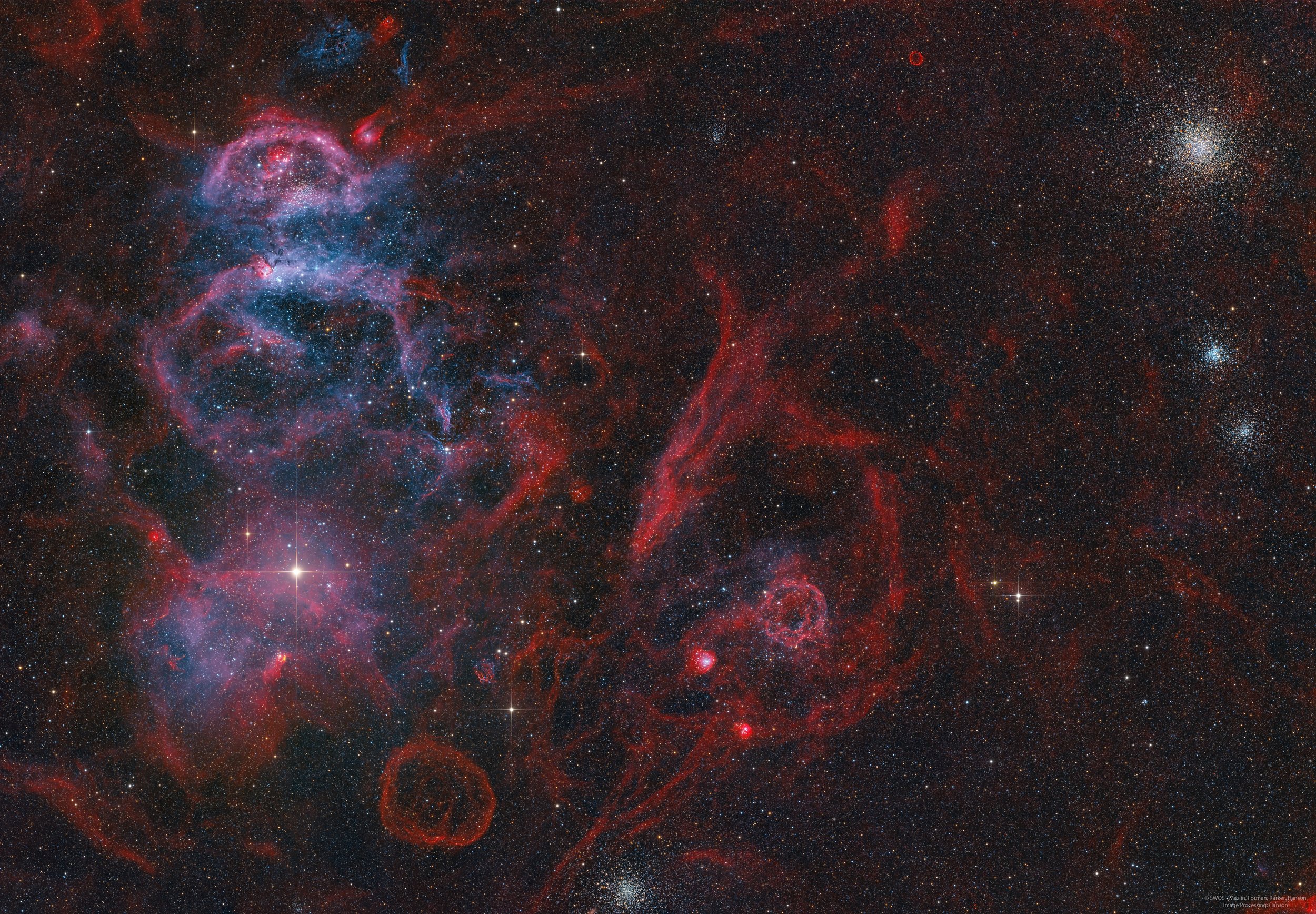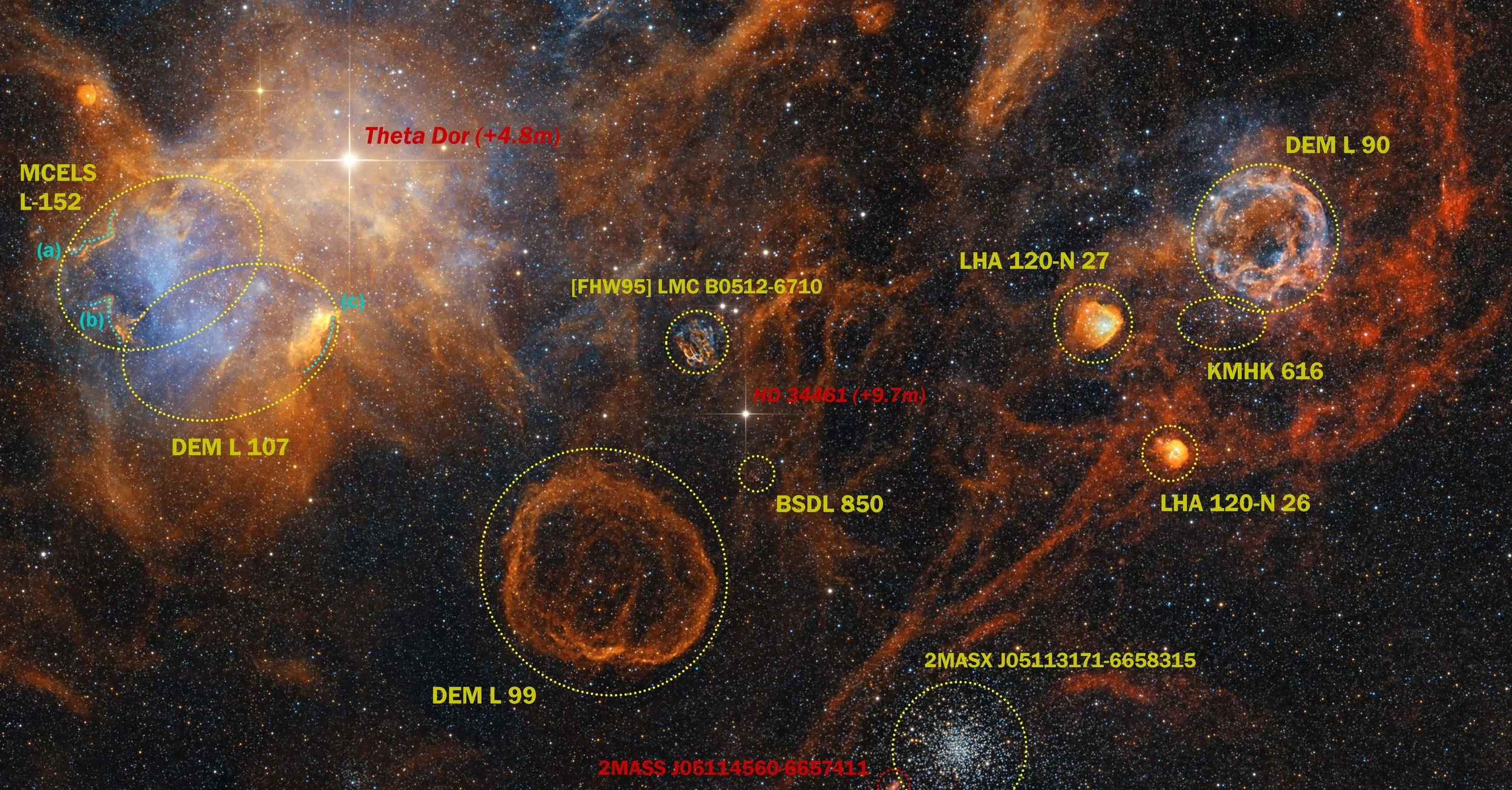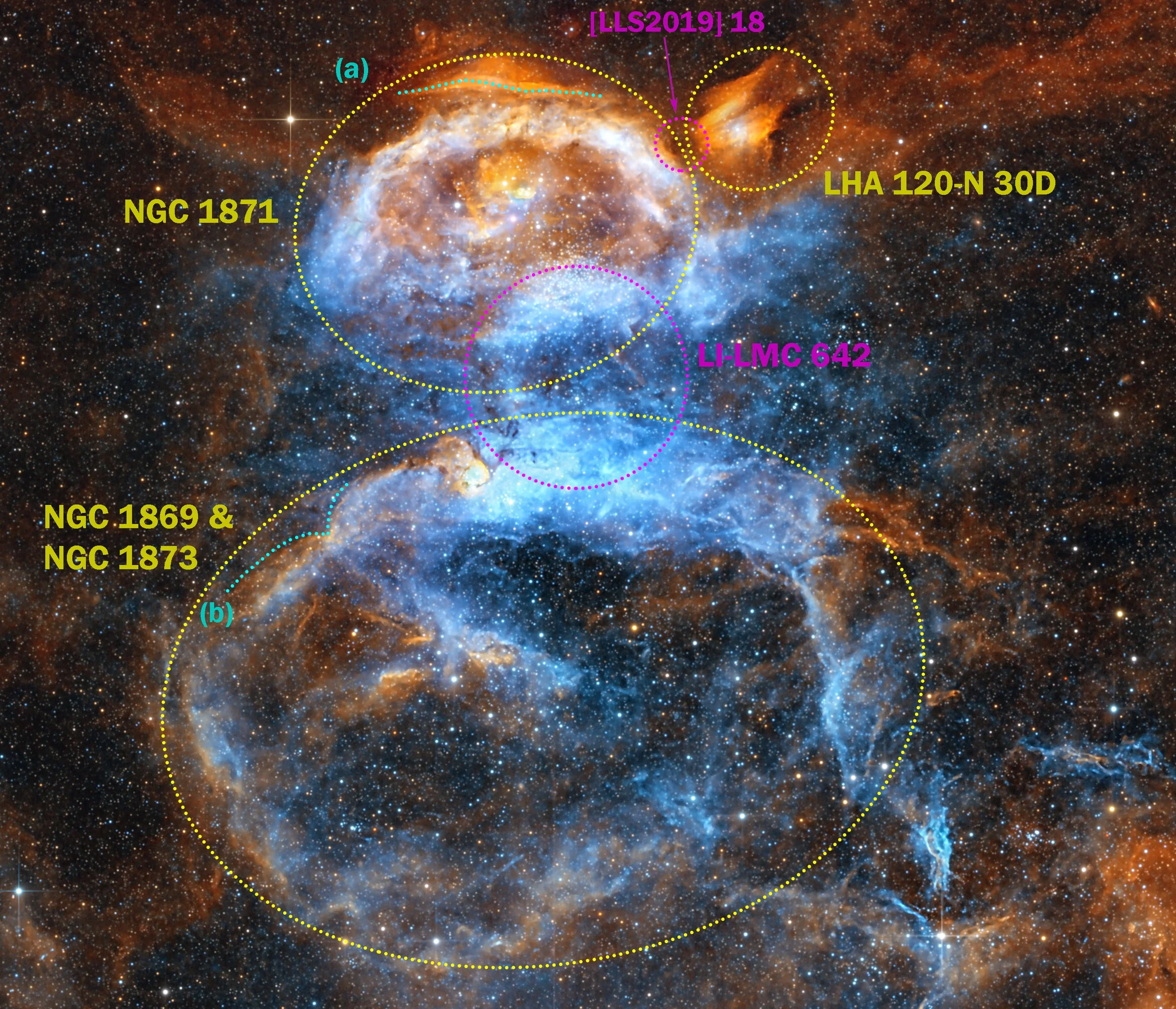Title: NGC 1871 The Portuguese Man O' War
In the dark void of our close galactic neighbor “The Large Magellanic Cloud” we find this rarely seen area NGC 1871 - The Portuguese Man O' War. Blinded by the trillions of stars lies the expansive area of emission nebula, Supernovas, Globular and open clusters.
Image Processing: Mark Hanson Description: Alexander Zaytsev
Enjoy, Mark & Alex
NGC 1871 Video
This wonderful and extensive description by Alexander Zaytsev
Nebulae complexes and star clusters in the vicinity of Theta Dor
The area in between Theta Dor [1] star and NGC 1871 open star cluster [2] in the vicinity of the Large Magellanic Cloud (LMC) contains an incredibly complex nebula complex comprised of HII regions, ionization fronts and supernova remnants (SNRs) that is complemented by other peculiarly shaped dim diffuse structures and the adornment of multiple globular and open star clusters stretching 40 arc.min West of Theta Dor. Since most of the diffuse structures in this frame belong to the LMC, the linear size of the sides of the image of 51.9 arc.min by 36 arc.min can be estimated as 1.82 kly by 1.26 kly at the distance to LMC taken as 158 kly.
Fig. 1 shows the lower left corner of the original image containing Theta Dor and multiple HII regions, SNRs, and star clusters of which the most prominent ones are:
A group of two adjacent HII regions DEM L 107 [3] and MCELS L-152 [4] in the vicinity of Theta Dor, containing what appears to be several neutral gas clouds with ionization fronts on the periphery (marked as (a) - (c) in Fig. 1).
A pair of HII regions DEM L 99 [5] and DEM L 90 [6] less complex on internal structure.
A pair of compact HII regions LHA 120-N 26 [7] and LHA 120-N 27 [8].
Compact SNR [FHW95] LMC B0512-6710 [9],
Open star clusters BSDL 850 [10], KMHK 616 [11], and 2MASX J05113171-6658315 [12] of which the latter much resembles a globular cluster but appears to be fully resolved up to the core and is accompanied by a background galaxy 2MASS J05114560-6657411 [13].
It appears that Theta Dor has extensive nebulosity around it with a radially symmetrical component which might be physically related to that star. Since the estimated distance to Theta Dor is 490 ly, it is possible that there is an overlap of much closer nebula on top of more distant structures belonging to the LMC here.
Fig. 2 shows the upper left portion of the of the original image containing the other two emission nebulae complexes connected to star associations NGC 1869 [14], NGC 1871 [15], and NGC 1873 [16] containing what appears to be two ionization fronts (marked as (a) and (b) in Fig. 2). In between of the two emission nebula complexes there appears to be a spherical region that could be identified as SNR LI-LMC 642 [17]. The other two prominent structures here are an emission nebula identifiable as LHA 120-N 30D [18] and a neutral gas cloud [LLS2019] 18 [19] sitting in the gap separating it from the outer wall of the nebula surrounding NGC 1871 star association.
Fig. 3 shows the upper right portion of the of the original image in which the most noticeable objects are:
Spread-around globular cluster NGC 1846 [20].
Open star clusters NGC 1842 [21] and NGC 1844 [22] that both resemble globular clusters, but getting resolved nearly to the core.
Compact SNR B0509-67.5 [23-25] also known as “Red Bubble” [26] that much resembles a planetary nebula but shows the characteristic fine structure of shock fronts on its boundary in the image obtained by the HST and Chandra [27-29].
Small open star cluster H88 188 [30].
The estimated physical diameter of the “Red Bubble” SNR is 23 ly [26] and the age estimate for it is only 400 ± 120 years old [24, 25] which makes it one of the youngest known SNRs in the radius of 200 kly and also one of just a few SNRs for which the light echo age was ever measured [31, 32]. While the SNR B0509-67.5 might be the object that received most attention in the literature so far in this entire region, the structure of the nebule surrounding Theta Dor and NGC 1871 association deserves further exploration with large aperture instruments.
[1] http://galaxymap.org/cat/view/rcw/108
[2] https://arxiv.org/pdf/0712.3005.pdf
[3] https://simbad.cds.unistra.fr/simbad/sim-id?Ident=DEM+L+107
[4] https://simbad.cds.unistra.fr/simbad/sim-id?Ident=MCELS+L-152
[5] https://simbad.cds.unistra.fr/simbad/sim-id?Ident=DEM+L+99
[6] https://simbad.cds.unistra.fr/simbad/sim-id?Ident=DEM+L+90
[7] https://simbad.cds.unistra.fr/simbad/sim-id?Ident=LHA+120-N+26
[8] https://simbad.cds.unistra.fr/simbad/sim-id?Ident=LHA+120-N+27
[9] https://simbad.cds.unistra.fr/simbad/sim-id?Ident=%5BFHW95%5D+LMC+B0512-6710
[10] https://simbad.cds.unistra.fr/simbad/sim-id?Ident=BSDL+850
[11] https://simbad.cds.unistra.fr/simbad/sim-id?Ident=KMHK+616
[12] https://simbad.cds.unistra.fr/simbad/sim-id?Ident=2MASX+J05113171-6658315
[13] https://simbad.cds.unistra.fr/simbad/sim-id?Ident=2MASS+J05114560-6657411
[14] https://simbad.cds.unistra.fr/simbad/sim-id?Ident=NGC+1869
[15] https://simbad.cds.unistra.fr/simbad/sim-id?Ident=NGC+1871
[16] https://simbad.cds.unistra.fr/simbad/sim-id?Ident=NGC+1873
[17] https://simbad.cds.unistra.fr/simbad/sim-id?Ident=LI-LMC+642
[18] https://simbad.cds.unistra.fr/simbad/sim-id?Ident=LHA+120-N+30D
[19] https://simbad.cds.unistra.fr/simbad/sim-id?Ident=%5BLLS2019%5D+18
[20] https://simbad.cds.unistra.fr/simbad/sim-id?Ident=NGC+1846
[21] https://simbad.cds.unistra.fr/simbad/sim-id?Ident=NGC+1842
[22] https://simbad.cds.unistra.fr/simbad/sim-id?Ident=NGC+1844
[23] https://simbad.cds.unistra.fr/simbad/sim-id?Ident=SNR+B0509-67.5
[24] https://iopscience.iop.org/article/10.1088/0004-637X/729/1/65
[25] https://iopscience.iop.org/article/10.1088/0004-637X/729/1/65/pdf
[26] https://hubblesite.org/contents/media/videos/896-Video
[27] https://esahubble.org/images/heic1018a/
[28] https://chandra.harvard.edu/photo/2010/snr0509/
[29] https://chandra.harvard.edu/photo/2008/snr0509/
[30] https://simbad.cds.unistra.fr/simbad/sim-id?Ident=H88+188
[31] https://iopscience.iop.org/article/10.3847/1538-4357/abfb02
[32] https://iopscience.iop.org/article/10.3847/1538-4357/abfb02/pdf
Imaged in LRGB with our PlaneWave CDK 24 at Observatorio El Sauce, Chile.
Image Processing: Mark Hanson
Description: Alexander Zaytsev
Data SWOS: Hanson, Mazlin, Parker, Forman
Enjoy,
Mark & Alex
Fig. 1. Cropped version of the image for the lower left corner of the original image shown at 100% resolution with annotations. The ionization fronts located at the periphery of HII regions DEM L 107 [3] and MCELS L-152 [4] are marked by the dashed curves (a) - (c).
Fig. 2. Cropped annotated version of the image for the upper left portion of original image shown at 100% resolution with annotations. The ionization fronts located at the periphery of emission nebulae shown here are marked by the dashed curves (a) and (b).
Fig. 3. Cropped annotated version of the image for the upper right portion of original image shown at 100% resolution with annotations.





